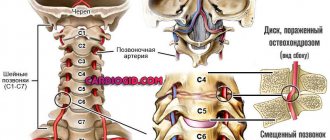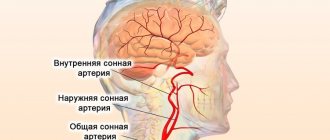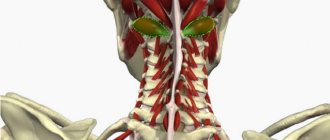The blood supply to the human brain is carried out thanks to the Circle of Willis, an arterial complex that includes the right and left branches of the vertebral arteries. They are separated from the subclavian artery and stretch towards the skull, where they break up into small vessels.
Normally, both vertebral arteries should be equally developed, but sometimes the formation of the left or right can be disrupted, resulting in a pathology called hypoplasia - let’s figure out what it is.
Hypoplasia - what is it?
The term hypoplasia in medicine describes a pathological process of a congenital nature, in which underdevelopment or changes occur in organs and tissues at the stage of their formation in the embryo.
This term is applicable to a variety of areas of the human body, from teeth to genitals, however, the topic of this article is hypoplasia of the arteries of the brain, in particular, vertebrates.
The vertebral arteries are part of the circle of Willis; they arise from the clavicular artery along with the carotid artery and provide blood supply to the brain. From the collection of these arteries, the vertebrobasilar basin is formed, which in turn is responsible for blood flow in the vertebrobasilar system and supplying the brain with blood.
As for cervical hypoplasia, the pathology is divided into three forms:
- Right-sided (most common).
- Left-handed.
- Bilateral (the rarest type of pathology).
The pathological process, which consists in underdevelopment of blood vessels, involves a narrowing of the left, right or both vertebral arteries. This developmental anomaly can also be called a type of vertebrobasilar insufficiency (VBI), in which not only narrowing of the carotid vessels of the neck, but also the vertebral arteries is possible. Under normal circumstances, all arteries of the cervical spine develop evenly.
It is important to know that the normal diameter of the right vertebral artery, as well as the left, is 3.6–3.8 millimeters; hypoplasia is diagnosed if this figure decreases to 2 millimeters or lower.
Hypoplasia of the cervical vessels, which are responsible for the blood supply to the brain, most affects the supply of blood to the posterior lobes of the brain. In most cases, the pathology leads to diseases of the heart, cardiovascular system, affects the vestibular apparatus, etc.
It is also worth noting that most doctors agree that the narrowing of the left or right arterial vessels is not much different, especially with regard to symptoms. The only significant difference is that the arteries are responsible for supplying blood to different parts of the brain, which is why the consequences differ.
To fully understand the development of the pathological process, it is worth considering its most common forms in more detail.
Research methods, diameter for hypoplasia
Hypoplasia can be detected by performing ultrasound diagnostics of the vessels of the head and neck using Dopplerography. With the normal structure of the common carotid artery, its diameter on both sides is from 0.5 to 0.8 cm, 4 mm is considered a critical value. Hypoplasia is manifested by a decrease in the speed of blood movement along the affected branch and acceleration in adjacent vessels.
For example, when the internal artery is underdeveloped, active blood flow is observed in the external one. Through it, blood flows to the visual, and then to the internal carotid.
To study patency, a functional test with clamping of the temporal artery can be performed. If at the same time the blood flow in the ophthalmic branch decreases, then the internal carotid artery has low patency.
Angiography using MRI can detect disturbances in the anatomical structure of the vessels of the carotid system, the degree of narrowing of the arterial branches and the adequacy of the development of collateral blood flow pathways.
Left vertebral artery
Being a less common form of pathology, hypoplasia of the left vertebral artery poses no less a threat to the human body.
The artery consists of 4 segments, which are conventionally designated as V1, V2, V3 (extracranial segments) and V4 (intracranial segment). The pathology of narrowing of the intracranial segment develops gradually, over years, which makes early detection of the problem almost impossible.
Hypoplasia of the left VA is invariably accompanied by a narrowing of the vascular lumen, which causes problems with blood circulation. The pathological process is characterized by difficulty in the patency of the vessel; the patient begins to stagnate blood, which leads to ischemia of certain areas of the brain, which are fed directly from the artery, anatomically located on the left.
The narrowing of the lumen of the vertebral arteries does not immediately make itself felt, including due to the body’s adaptive systems. At the same time, clinical signs become more pronounced due to age-related changes in the structure.
You should be concerned about this problem if you experience systematic pain in the cervical spine. The diagnosis of hypoplasia of the left VA, in addition to other complications, very often leads to the development of hypertension.
Clinical manifestations
An asymptomatic course is observed when one of the branches of the carotid artery is underdeveloped, if there is sufficient blood flow through the anastomoses between the remaining vessels. With increased stress (professional sports, childbirth, second half of pregnancy, heavy lifting), atherosclerosis, inflammatory processes, stress, hypertensive crisis, transient ischemic attacks occur.
Such attacks can be brief or last up to several hours, depending on the state of the collateral network. The most common signs of decreased blood flow through the carotid arteries are:
- weakness in an arm or arm and leg on one side;
- blurred vision in one eye - spots, flashes of light, partial blindness;
- numbness of half the face, fingers;
- nausea, dizziness;
- headache.
Speech disorders, convulsions, difficulty swallowing, and loss of vision due to retinal infarction appear less frequently. Frequent ischemic attacks are precursors to the development of stroke. It occurs with similar symptoms, but more pronounced and lasting for a long period of time.
Expert opinion
Alena Ariko
Expert in Cardiology
In some cases, the symptoms of carotid artery hypoplasia do not have pronounced neurological abnormalities, and patients turn to neurologists with complaints of irritability, depressed mood or frequent fluctuations in the emotional background, insomnia, and memory impairment. In a child, a sign of a vascular abnormality may be attention deficit hyperactivity disorder.
Right vertebral artery
According to statistics, hypoplasia of the right vertebral artery occurs once in every tenth person, that is, it affects 10 people out of 100.
Narrowing of the right VA in most cases is also a congenital pathology. This form of the pathological process is also accompanied by impaired blood supply, however, ischemia and blood stagnation in this case occur less frequently.
Doctors call concomitant diseases of the circulatory system and blood vessels the main danger factor for PPA hypoplasia. If hypoplasia of the vertebral artery on the right is accompanied, for example, by vascular atherosclerosis, the development of the second disease and associated degenerative changes in the head will proceed many times faster than if the disease developed independently.
The severity of the pathological process largely depends on how extensive it is. The disease can affect the posterior communicating artery, cover all 4 segments (segments of the artery are not involved in the pathological process immediately, but one at a time), etc. In cases where the pathology takes on a severe course, is complicated by other diseases, affects the vertebrobasilar system and concerns vertebral artery, the patient may experience decreased sensitivity in certain areas of the body. This is a clear sign of circulatory problems in the corresponding area of the brain; in such situations, immediately consult a doctor and undergo an examination.
Danger and consequences
Disorders associated with hypoplasia are often attributed to other vascular diseases, which makes the diagnosis of pathology much more complicated. If not treated in a timely manner, its consequences may include deterioration in vision, hearing and functioning of the vestibular apparatus, changes in the composition of blood and other biological fluids , as well as atherosclerosis and thrombosis.
Therefore, at the first suspicion of hypoplasia, the patient should consult a doctor as soon as possible.
Causes
Hypoplasia, that is, an anomaly in the development of tissues or an organ, which in this case concerns the vertebral arteries, as mentioned earlier, is a congenital pathology. This means that the main reason for underdevelopment of the artery is problems in the embryonic stages. At the same time, a number of factors can be identified that contribute to the fact that hypoplasia of the vertebral artery occurs in a newborn and manifests itself at a certain age:
- Infectious diseases transmitted by the mother during pregnancy.
- Exposure of the fetus to radiation or ionizing exposure.
- Mechanical injuries, including blows, bruises and other injuries to the abdominal cavity during pregnancy.
- Narrowing of the artery in a newborn can be caused by a genetic predisposition, for example, if the family history includes pathologies of a vascular nature.
- Toxic factor - if during pregnancy a woman smoked, abused alcohol, worked at a chemical plant, or took any potent drugs for a long time, there is a high probability that hypoplasia may be associated with each of these factors.
Symptoms
As mentioned earlier, in the early stages, signs of hypoplasia may be completely absent. The development of the pathological process can last for years and only when the arterial lumen narrows to a certain value will some symptoms appear.
The paradox is that in the complete absence of manifestations of pathology in the early stages, the entry of the disease into the so-called active phase is accompanied by a rich clinical picture. However, in each patient with narrowing of the vertebral artery (right or left), symptoms manifest themselves completely differently:
- Headaches of different nature and specificity. Painful sensations can be periodic or constant, intensify after intense physical activity or occur at rest. With hypoplasia of the cerebral artery, the pain also differs in intensity, from strong, which has to be relieved with analgesics, to weak, which many tolerate without medication. As for the specifics, in most cases we are talking about dull and aching pain, however, they can also be sharp, stabbing.
- Unreasonable dizziness indicates cerebral circulatory disorders. This clinical sign is the second most common and also varies in nature. In some cases, dizziness is not associated with physical exertion, emotional state and other factors; they simply occur more frequently and disappear as quickly as they appeared. In other cases, dizziness begins after a change in body position, any load, stress, etc.
- Often hypoplasia of the right vertebral artery is accompanied by emotional disturbances. A person experiences frequent and sudden changes in mood, depression, which can last up to 2-3 days, then disappear without a trace, constant lethargy, states of apathy and even depressive states.
- If we talk about hypoplasia of the left vertebral artery, this form of the pathological process is more often characterized by changes in blood pressure. Yes, with right-sided hypoplasia they are also present in the clinical picture, but in this case they are noted more often.
- The pathology affects the patient’s body with a state of drowsiness, fatigue, and a feeling of weakness. People with hypoplasia do not get enough sleep even with a full, sound eight-hour sleep, are in a lethargic state, and often yawn.
- The pathology may be accompanied by disorders affecting the vestibular apparatus. In this case, dizziness is also present among the clinical signs, but they become more intense, and are accompanied by nausea, excessive sweating, and changes in skin color (pallor or, conversely, redness of the face). The clearest signs of damage to the vestibular apparatus and the progression of this pathology will be impaired coordination. A loss of balance appears, the gait becomes uncertain, the person sways from side to side, all movements become unclear, and loss of space may develop.
Over time, the symptoms worsen; severe forms of vertebral artery hypoplasia are accompanied by damage to the nervous system. On the one hand, this is expressed in numbness of certain parts of the body (usually limbs), on the other, visual hallucinations. In some cases, partial paralysis even occurs.
Diagnostics
The patient learns about the disease when the first symptoms appear; in 95% of cases, it is at these stages that they consult a doctor and diagnose hypoplasia. Diagnostic measures involve the following examinations:
- Ultrasound of the vessels of the brain and cervical spine, during which the doctor records the parameters of the arteries being examined (diameter, condition, etc.). If, through this analysis, the diameter of the arteries is less than 2 millimeters. The ultrasound result confirms or refutes the diagnosis of vertebral artery hypoplasia.
- Among the diagnostic methods there is computed tomography of the cervical and head regions using a contrast agent.
- Angiography is an assessment of the functional state of blood vessels, their patency; the severity of the pathological process and the areas of the arteries involved in it are revealed.
Depending on the patient’s complaints, his age, the nature of the pathological process and other factors, additional examinations may be required, for example, diagnosis of heart disease, etc.
Classification
Pathogenetically, SPA is classified according to the type of hemidynamic disorder. According to this classification, compression-type vertebral artery syndrome is caused by mechanical compression of the artery. The angiospastic variant occurs with a reflex spasm caused by irritation of the receptor apparatus in the area of the affected spinal segment. It manifests itself predominantly as vegetative-vascular disorders, weakly dependent on head movements. Irritative spasm occurs when the fibers of the periarterial sympathetic plexus are irritated. Most often, vertebral artery syndrome is mixed. The compression-irritative type of SPA is typical for lesions of the lower cervical region, and the reflex type is associated with pathology of the upper cervical vertebrae. The clinical classification divides SPA into dystonic and ischemic, which are stages of one pathological process. The dystonic variant is functional. At this stage, the clinical picture is characterized by cephalalgia (headache), cochleo-vestibular and visual symptoms. Cephalgia is pulsating or aching, accompanied by vegetative symptoms, and is constant with periods of intensification, often provoked by movements in the neck or its forced position. Ischemic SPA is an organic stage, i.e., it is accompanied by morphological changes in cerebral tissues. Clinically, acute stroke occurs in the vertebrobasilar region, which can be transient (reversible) in nature or cause persistent neurological deficit. In the first case they talk about TIA, in the second - about ischemic stroke. At the ischemic stage of RAS, vestibular ataxia, nausea with vomiting, and dysarthria are observed. Transient ischemia of the brain stem leads to a drop attack, and a similar process in the area of the reticular formation leads to syncopal paroxysm. Typically, the SPA clinic is a combination of several of the options below, but one specific syndrome may take the leading place. Basilar migraine occurs with cephalgia in the occipital region, vestibular ataxia, repeated vomiting, tinnitus, and sometimes dysarthria.
Often, basilar migraine manifests itself as a classic migraine with aura.
Aura is characterized by visual disturbances: flickering spots or iridescent stripes located in both eyes, blurred vision, and the appearance of “fog” before the eyes. By the nature of the aura, basilar migraine is ophthalmic. Barre's syndrome.
Lieu is also called posterior cervical sympathetic syndrome.
There is pain in the neck and back of the head, spreading to the parietal and frontal parts of the head. Cephalgia occurs and worsens after sleep (in the case of an unsuitable pillow), turning the head, shaking or walking. It is accompanied by vestibulo-cochlear, autonomic and ophthalmic symptoms. Vestibule.
Atactic syndrome - dizziness, provoked by turning the head, predominates.
There is vomiting and episodes of darkening of the eyes. Vestibular ataxia is expressed in a feeling of instability while walking, staggering, and imbalance. Ophthalmic syndrome includes visual fatigue during exercise, transient flickering scotomas in the field of view, transient photopsia (short-term flashes, sparks in the eyes).
Temporary partial or complete bilateral paroxysmal loss of visual fields is possible.
Some patients experience conjunctivitis: redness of the conjunctiva, pain in the eyeball, a feeling of “sand in the eyes.” Vestibule.
Cochlear syndrome is manifested by dizziness, a feeling of unsteadiness, persistent or transient tinnitus, the nature of which varies depending on the position of the head.
A mild degree of hearing loss may occur with impaired perception of whispered speech, which is reflected in the audiogram data. Paracusia is possible - better perception of sounds against a background of noise than in complete silence. The syndrome of autonomic disorders is usually combined with other syndromes and is always observed during periods of exacerbation of SPA.
It is characterized by hot or cold flashes, hyperhidrosis, coldness of the distal extremities, a feeling of lack of air, tachycardia, changes in blood pressure, and chills.
Sleep disturbances may occur. Transient ischemic attacks characterize organic SPA.
The most typical are temporary motor and sensory disturbances, homonymous hemianopsia, dizziness with vomiting, vestibular ataxia not caused by vertigo, diplopia, dysarthria and dysphagia.
Unterharnscheidt syndrome.
A short-term “switching off” of consciousness, provoked by a sharp turn of the head or its uncomfortable position. Duration may vary. After regaining consciousness, weakness in the limbs persists for some time.
Treatment
There is currently no complete drug treatment for this pathology. For this reason, the answer to the question regarding how to treat hypoplasia, the answer will be various auxiliary and symptomatic measures.
In addition, treatment of hypoplasia of the right vertebral artery is carried out comprehensively, it consists of:
- Conservative therapy.
- Treatment with folk remedies.
- As a last resort, surgical intervention.
Drug therapy
Drug therapy is a conservative method that involves taking medications from the following groups:
- Vasodilators - improve blood flow, relieving the patient of a lot of accompanying symptoms, increase the quality and length of life, and prevent the development of complications;
- Anticoagulants are aimed at thinning the blood, thereby preventing the formation of blood clots.
Additionally, it is important to focus on treating comorbidities, if any.
Folk remedies
Traditional medicine is not able to replace drug treatment, but acts as an auxiliary option that allows you to keep the disease in check. Let's consider the most effective methods of treatment with folk remedies:
- You cannot find a better natural remedy for dilating blood vessels than hawthorn. It is enough to take 40 grams of the fruits of the plant, pour 500 milliliters of boiling water in a thermos, close tightly and leave for 30-40 minutes. The product is drunk three times a day, 50 milliliters on an empty stomach;
- A vasodilator herbal tea can dilate blood vessels and improve the condition. Mix equal amounts of yarrow, immortelle, St. John's wort, chamomile and birch buds. Then pour 15-20 grams of thoroughly mixed collection with 500 milliliters of water, leave for 30 minutes, strain and consume 250 ml in the morning and evening.
Surgical intervention
An extreme measure that is resorted to if conservative treatment methods do not give the desired effect and the patient’s condition continues to deteriorate. The operation can help normalize blood flow; it involves inserting a stent into the artery, designed to widen its lumen.
Prevention
Since the disease is congenital, prevention of its development in a newborn depends on the mother. Throughout pregnancy, you need to monitor your health, prevent severe infectious diseases (get tested in advance), and give up bad habits. A woman should lead a healthy lifestyle, protect the fetus from mechanical damage, not overwork herself, not be nervous, etc. Hypoplasia of the vertebral artery is a dangerous pathological process that requires constant monitoring and appropriate treatment. If the disease is dealt with appropriately, all negative effects and complications can be avoided.
(
4 ratings, average: 4.00 out of 5)











